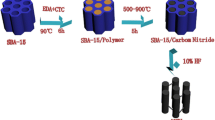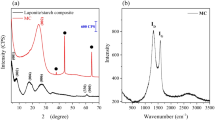Abstract
Pollution of water sources by industrial dyes is a priority concern around the world that the human health and the environment are being threatened by them. Therefore, efforts to remove them from wastewater are attracted considerable attention worldwide. For the first time, carbon dots (CDs) were synthesis from an l-histidine amino acid and citric acid with a 1:4 molar ratio, which quantum yield was obtained to be 39.34%. In the next step, the prepared CDs are embedded into hexagonal mesoporous silica (HMS) as an effective adsorbent to eliminate the Methylene Blue (MB) dye. The impact of operational adsorption parameters, including solution pH (3.0–11.0), contact time (10.0–180 min), adsorbent dosage (0.05–0.10 g), and initial concentrations of MB dye (10–100 mg/L) were investigated. The removal efficiency and equilibrium adsorption capacity have been determined at 97.0% and 47.0 mg/g, respectively, under optimum situations at 298 K and pH = 7.0. The isotherm of the adsorption was fitted with both Freundlich and Langmuir models, and the kinetics studies of MB dye removal pursued the pseudo-second-order model. In addition, thermodynamic evaluations indicated that the adsorption procedure had spontaneous and endothermic nature. Accordingly, this study demonstrates that CDs/HMS could be utilized as a promising adsorbent for the elimination of MB dye as a cationic dye model from an aqueous solution.









Similar content being viewed by others
References
Abdulhameed AS, Mohammad A-T, Jawad AH (2019) Modeling and mechanism of reactive orange 16 dye adsorption by chitosan-glyoxal/TiO2 nanocomposite: application of response surface methodology. Desalin Water Treat 164:346–360
Aivalioti M, Vamvasakis I, Gidarakos E (2010) BTEX and MTBE adsorption onto raw and thermally modified diatomite. J Hazard Mater 178(1–3):136–143
Al-Futaisi A, Jamrah A, Al-Hanai R (2007) Aspects of cationic dye molecule adsorption to palygorskite. Desalination 214(1–3):327–342
Ali I, Asim M, Khan TA (2012) Low cost adsorbents for the removal of organic pollutants from wastewater. J Environ Manage 113:170–183
Amrhar O, Nassali H, Elyoubi M (2015) Adsorption of a cationic dye, methylene blue, onto moroccan illitic clay. J Mater Environ Sci 6(11):3054
Arends IW, Sheldon RA, Wallau M, Schuchardt U (1997) Oxidative transformations of organic compounds mediated by redox molecular sieves. Angew Chem Int Ed Engl 36(11):1144–1163
Asouhidou DD, Triantafyllidis KS, Lazaridis NK, Matis KA (2009) Adsorption of Remazol Red 3BS from aqueous solutions using APTES-and cyclodextrin-modified HMS-type mesoporous silicas. Coll Surf A Physicochem Eng Asp 346(1–3):83–90
Atchudan R, Edison TNJI, Perumal S, Karthik N, Karthikeyan D, Shanmugam M, Lee YR (2018) Concurrent synthesis of nitrogen-doped carbon dots for cell imaging and ZnO@ nitrogen-doped carbon sheets for photocatalytic degradation of methylene blue. J Photoch Photobio A 350:75–85
Başar CA (2006) Applicability of the various adsorption models of three dyes adsorption onto activated carbon prepared waste apricot. J Hazard Mater 135(1–3):232–241
Bonetto L, Crespo J, Guégan R, Esteves V, Giovanela M (2021) Removal of methylene blue from aqueous solutions using a solid residue of the apple juice industry: full factorial design, equilibrium, thermodynamics and kinetics aspects. J Mol Struct 1224:129296
Brião GV, Jahn SL, Foletto EL, Dotto GL (2018) Highly efficient and reusable mesoporous zeolite synthetized from a biopolymer for cationic dyes adsorption. Coll Surf A Physicochem Eng Asp 556:43–50
Calimli MH, Nas MS, Burhan H, Mustafov SD, Demirbas Ö, Sen F (2020) Preparation, characterization and adsorption kinetics of methylene blue dye in reduced-graphene oxide supported nanoadsorbents. J Mol Liq 309:113171
Chakraborty T, Islam M, Zaman S, Kabir A, Ghosh G (2020) Jute (Corchorus olitorius) stick charcoal as a low-cost adsorbent for the removal of methylene blue dye from aqueous solution. SN Appl Sci 2(4):1–10
Chaudhry SA, Zaidi Z, Siddiqui SI (2017) Isotherm, kinetic and thermodynamics of arsenic adsorption onto Iron-Zirconium Binary Oxide-Coated Sand (IZBOCS): modelling and process optimization. J Mol Liq 229:230–240
Chiu Y-H, Chang T-FM, Chen C-Y, Sone M, Hsu Y-J (2019) Mechanistic insights into photodegradation of organic dyes using heterostructure photocatalysts. Catalysts 9(5):430
El-Shamy AG (2020) An efficient removal of methylene blue dye by adsorption onto carbon dot@ zinc peroxide embedded poly vinyl alcohol (PVA/CZnO2) nano-composite: a novel reusable adsorbent. Polymer 202:122565
El-Shamy AG, Zayied H (2020) New polyvinyl alcohol/carbon quantum dots (PVA/CQDs) nanocomposite films: structural, optical and catalysis properties. Synth Met 259:116218
Emami E, Mousazadeh MH (2021) Green synthesis of carbon dots for ultrasensitive detection of Cu2+ and oxalate with turn on-off-on pattern in aqueous medium and its application in cellular imaging. J. Photochem Photobiol A 418:113443
Emami E, Mousazadeh MH (2021) pH-responsive Zwitterionic carbon dots for detection of Rituximab antibody. Luminescence 36(2):1198–1208
Emami E, Zolfaghari P, Golizadeh M, Karimi A, Lau A, Ghiasi B, Ansari Z (2020) Effects of stabilizers on sustainability, activity and decolorization performance of manganese peroxidase enzyme produced by Phanerochaete chrysosporium. J Environ Chem Eng 8(6):104459
Freundlich H (1906) Over the adsorption in solution. J Phys Chem 57(385471):1100–1107
Fu H, Li X, Wang J, Lin P, Chen C, Zhang X, Suffet IM (2017) Activated carbon adsorption of quinolone antibiotics in water: performance, mechanism, and modeling. J Environ Sci 56:145–152
gamal El-Shamy A (2020) New carbon quantum dots nano-particles decorated zinc peroxide (Cdots/ZnO2) nano-composite with superior photocatalytic efficiency for removal of different dyes under UV-A light. Synth Met 267:116472
Giwa A, Yusuf A, Balogun HA, Sambudi NS, Bilad MR, Adeyemi I, Chakraborty S, Curcio S (2020) Recent advances in advanced oxidation processes for removal of contaminants from water: a comprehensive review. Process Saf Environ Prot 146:220–256
Han R, Zou W, Yu W, Cheng S, Wang Y, Shi J (2007) Biosorption of methylene blue from aqueous solution by fallen phoenix tree’s leaves. J Hazard Mater 141(1):156–162
Hao L, Gao W, Yan S, Niu M, Liu G, Hao H (2020) Functionalized diatomite/oyster shell powder doped electrospun polyacrylonitrile submicron fiber as a high-efficiency adsorbent for removing methylene blue from aqueous solution: thermodynamics, kinetics and isotherms. J Mol Liq 298:112022
Ho Y-S, McKay G (1998) Sorption of dye from aqueous solution by peat. Chem Eng 70(2):115–124
Jawad AH, Abdulhameed AS (2020) Mesoporous Iraqi red kaolin clay as an efficient adsorbent for methylene blue dye: adsorption kinetic, isotherm and mechanism study. Surf Interfaces 18:100422
Jawad AH, Mohammed IA, Abdulhameed AS (2020) Tuning of fly ash loading into chitosan-ethylene glycol diglycidyl ether composite for enhanced removal of reactive red 120 dye: optimization using the box-behnken design. J Polym Environ 28(10):2720–2733
Khanday W, Marrakchi F, Asif M, Hameed B (2017) Mesoporous zeolite–activated carbon composite from oil palm ash as an effective adsorbent for methylene blue. J Taiwan Inst Chem Eng 70:32–41
Kuzminska M, Kovalchuk TV, Backov R, Gaigneaux EM (2014) Immobilizing heteropolyacids on zirconia-modified silica as catalysts for oleochemistry transesterification and esterification reactions. J Catal 320:1–8
Langmuir I (1916) The constitution and fundamental properties of solids and liquids. Part I. Solids. J Am Chem Soc 38(11):2221–95
Lata H, Garg V, Gupta R (2007) Removal of a basic dye from aqueous solution by adsorption using parthenium hysterophorus: an agricultural waste. Dyes Pigm 74(3):653–658
Liu J, Liu Q, Yang H (2016) Assessing water scarcity by simultaneously considering environmental flow requirements, water quantity, and water quality. Ecol Indic 60:434–441
Low LW, Teng TT, Morad N, Azahari B (2012) Studies on the adsorption of methylene blue dye from aqueous solution onto low-cost tartaric acid treated bagasse. APCBEE Proc 1:103–109
Ma D, Zhu B, Cao B, Wang J, Zhang J (2017) Fabrication of the novel hydrogel based on waste corn stalk for removal of methylene blue dye from aqueous solution. Appl Surf Sci 422:944–952
Maddu A, Meliafatmah R, Rustami E (2021) Enhancing photocatalytic degradation of methylene blue using ZnO/Carbon dots nanocomposite derived from coffee grounds. Pol J Environ Stud 30(1):273–282
Man Y, Li Z, Kong W-L, Li W, Dong W, Wang Y, Xie F, Zhao D, Qu Q, Zou W-S (2020) Starch fermentation wastewater as a precursor to prepare S, N-doped carbon dots for selective Fe (III) detection and carbon microspheres for solution decolorization. Microchem J 159:105338
Marrakchi F, Hameed B, Bouaziz M (2020) Mesoporous and high-surface-area activated carbon from defatted olive cake by-products of olive mills for the adsorption kinetics and isotherm of methylene blue and acid blue 29. J Environ Chem Eng 8(5):104199
Meng LY, Zhai SR, Li S, Zhai B, An QD, Song XW (2014) Synthesis and characterization of tungstophosphoric Acid/Pentaethylenehexamine/ZrSBA-15 and its use in the selective oxidation of benzyl alcohol under solvent-free conditions. Eur J Inorg Chem 14:2337–44
Molinos-Senante M, Donoso G (2016) Water scarcity and affordability in urban water pricing: a case study of Chile. Util Policy 43:107–116
Mouni L, Belkhiri L, Bollinger J-C, Bouzaza A, Assadi A, Tirri A, Dahmoune F, Madani K, Remini H (2018) Removal of methylene blue from aqueous solutions by adsorption on kaolin: kinetic and equilibrium studies. Appl Clay Sci 153:38–45
Naresh Yadav D, Anand Kishore K, Saroj D (2020) A study on removal of methylene blue dye by photo catalysis integrated with nanofiltration using statistical and experimental approaches. Environ Technol 42(19):2968–2981
Oladipo AA, Ifebajo AO (2018) Highly efficient magnetic chicken bone biochar for removal of tetracycline and fluorescent dye from wastewater: two-stage adsorber analysis. J Environ Manage 209:9–16
Papaioannou N, Titirici M-M, Sapelkin A (2019) Investigating the effect of reaction time on carbon dot formation, structure, and optical properties. ACS Omega 4(26):21658–21665
Prakash S, Kumar M, Tripathi BP, Shahi VK (2010) Sol–gel derived poly (vinyl alcohol)-3-(2-aminoethylamino) propyl trimethoxysilane: cross-linked organic–inorganic hybrid beads for the removal of Pb (II) from aqueous solution. Chem Eng 162(1):28–36
Prarat P, Ngamcharussrivichai C, Khaodhiar S, Punyapalakul P (2019) Adsorption of single and mixed haloacetonitriles on silica-based porous materials: mechanisms and effects of porous structures. J Environ Sci 79:346–360
Rashid S, Shen C, Yang J, Liu J, Li J (2018) Preparation and properties of chitosan–metal complex: some factors influencing the adsorption capacity for dyes in aqueous solution. J Environ Sci 66:301–309
Sahiner N, Suner SS, Sahiner M, Silan C (2019) Nitrogen and sulfur doped carbon dots from amino acids for potential biomedical applications. J Fluoresc 29(5):1191–1200
Shiraishi Y, Morishita M, Teshima Y, Hirai T (2006) Vanadium-containing mesoporous silica of high photocatalytic activity and stability even in water. J Phys Chem B 110(13):6587–6594
Temkin M (1940) Kinetics of ammonia synthesis on promoted iron catalysts. Acta Physiochim 12:327–356
Teymoorian T, Hashemi N, Mousazadeh MH, Entezarian Z (2021) N, S doped carbon quantum dots inside mesoporous silica for effective adsorption of methylene blue dye. SN Appl Sci 3(3):1–14
Wang J, Han F, Rao Y, Hu T, Huang Y, Cao J-j, Lee SC (2018) Visible-light-driven nitrogen-doped carbon quantum dots/CaTiO3 composite catalyst with enhanced NO adsorption for NO removal. Ind Eng Chem Res 57(31):10226–10233
Wang X, Li X, Li X, Wang Y, Han Q, Li J (2020a) Determination of 2, 4, 6-trinitrophenol by in-situ assembly of SBA-15 with multi-hydroxyl carbon dots. Anal Chim Acta 1098:170–180
Wang Y, Zhou Y, Jiang G, Chen P, Chen Z (2020b) One-step fabrication of carbonaceous adsorbent from corncob for enhancing adsorption capability of methylene blue removal. Sci Rep 10(1):1–9
Yao S, Lai H, Shi Z (2013) Adsorption of methylene blue from aqueous solution using acetic acid modified rice bran. J Indian Chem Soc 90(5):629–635
Yuzbashi S, Mousazadeh M, Ramezani N, Sid Kalal H, Sabour B (2020) Mesoporous zirconium–silica nanocomposite modified with heteropoly tungstophosphoric acid catalyst for ultra-deep oxidative desulfurization. Appl Organomet Chem 34(2):e5326
Zeng Y-W, Ma D-K, Wang W, Chen J-J, Zhou L, Zheng Y-Z, Yu K, Huang S-M (2015) N, S co-doped carbon dots with orange luminescence synthesized through polymerization and carbonization reaction of amino acids. Appl Surf Sci 342:136–143
Acknowledgements
The authors would like to gratefully thank the Amirkabir University of Technology (AUT), Tehran, Iran, for their financial support.
Author information
Authors and Affiliations
Corresponding author
Additional information
Editorial responsibility: Lifeng Yin.
Supplementary Information
Below is the link to the electronic supplementary material.
Rights and permissions
About this article
Cite this article
Jaberi, H., Emami, E. & Mousazadeh, M.H. CDs/HMS for removal of MB dye with highly adsorption capacity: isotherm, kinetic, and thermodynamic study. Int. J. Environ. Sci. Technol. 19, 5167–5180 (2022). https://doi.org/10.1007/s13762-021-03723-2
Received:
Revised:
Accepted:
Published:
Issue Date:
DOI: https://doi.org/10.1007/s13762-021-03723-2




